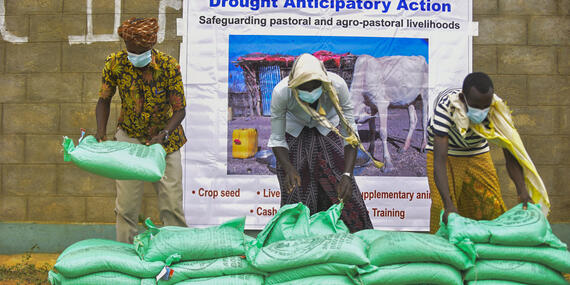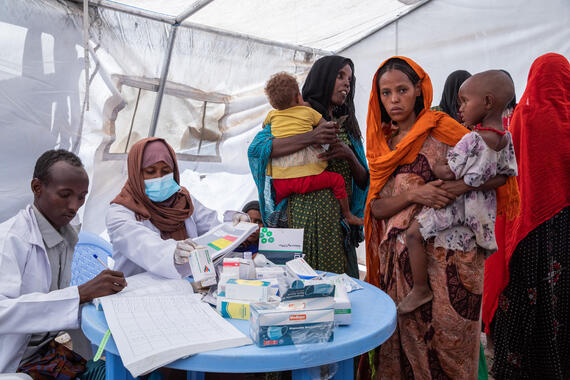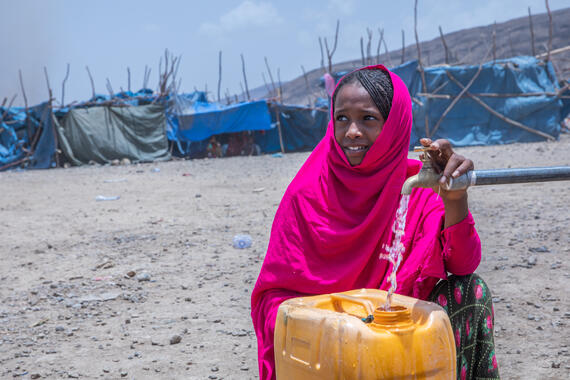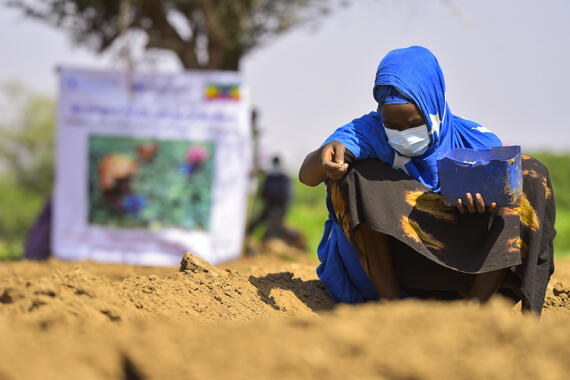Acting early in Ethiopia when the world isn’t watching

By Kate Katch
When a country is hit by a sudden natural hazard – an earthquake, a tsunami or floods – the impact is immediate, the crisis makes headlines and aid often follows. But when a country is hit by a slow-moving extreme event, such as a drought, the crisis unfolds in slow motion: crops fail, livestock die, people sell their assets and leave their homes, women and girls risk their safety as they walk further to find water, and children are pulled out from school.
This has been Ethiopia’s experience, time and time again.
Between October 2020 and June 2022, Ethiopia experienced five consecutive below-average rainy seasons, with the 2022 March-May season being the driest in 70 years. The drought’s prolonged nature ultimately affected an estimated 17 million people.
But this time there was a glimmer of hope.
The humanitarian community acted earlier thanks to OCHA piloting an anticipatory action framework. The OCHA-managed Central Emergency Response Fund (CERF) provided US$20 million to humanitarian partners to reduce the drought’s impact on more than 900,000 people.
“The Ethiopia anticipatory action pilot demonstrated that if we act earlier, people’s lives will be better,” said Joyce Msuya, the Assistant Secretary-General for Humanitarian Affairs and Deputy Emergency Relief Coordinator. “In 2024, drought is once again driving millions of people to suffer... we have the evidence, now we must scale.”

The challenge
Ethiopia is highly vulnerable to severe seasonal droughts; it has experienced them every decade since 1953. They are compounded by conflict, locust invasions, high food prices and localized flooding, meaning communities in Ethiopia continuously receive humanitarian aid.
Over CERF’s 18-year history, Ethiopia has consistently ranked among its top five recipient countries, having received a total of $500 million. Approximately 40 per cent of that funding has gone to drought relief.
Droughts are predictable, but they too often fail to receive funding until suffering reaches catastrophic levels and dramatic images hit the media.

The solution
In 2020, OCHA and its partners piloted an anticipatory action framework in Ethiopia to see how the humanitarian community could get ahead of drought and reduce its impact on vulnerable communities.
Anticipatory action frameworks use a model or forecast to trigger pre-arranged funding for pre-agreed activities. In essence, a framework pre-determines exactly when funding will be released and who will take what action. OCHA’s Centre for Humanitarian Data developed a trigger for Ethiopia that would be activated if climate forecasts suggested below-average rainfall during the coming rainy season, and if food security conditions were expected to deteriorate.
By late November 2020, four regions in Ethiopia met the food insecurity criteria for the trigger of the anticipatory action framework. Almost 13 million people were projected to experience crisis or emergency levels of food insecurity within six months (by June 2021). Not all seasonal climate forecasts met the trigger threshold – some were more certain in predicting a below-average rainfall than others.
The forecasts’ uncertainty did not stop a no-regrets approach. In December 2020 – earlier than any other donor – CERF provided the funding that humanitarian partners needed to reduce the drought’s impact.
According to a satisfaction survey carried out by 60 decibels, three out of five recipients of assistance reported an improved ability to afford food, livelihood inputs and household bills.

Tens of thousands of households received seeds that germinate quickly and/or are drought tolerant, livestock supplementary feed and animal health services, and unconditional cash grants.[1] By utilizing existing community-based structures, almost 250,000 community members learned about child protection risks, including gender-based violence and early child marriage.[2] More than 80,000 people were able to access safe drinking water through the early rehabilitation of boreholes and non-functioning water supply systems, including in health facilities and schools.[3]
As one recipient of anticipatory action aid provided by the Food and Agriculture Organization
noted: “My family benefited from the assistance, as we used the money to buy food items. In addition, we spent the money to take care of our children, and the animal feed support was also helpful for our livestock, as there was inadequate pasture.”
The takeaway
In a world where humanitarian crises compete for political attention and resources, Ethiopia illustrates that anticipatory action frameworks make acting early the default.
Catherine Sozi, the former UN Resident and Humanitarian Coordinator for Ethiopia, explained: “In late 2020 and 2021, media headlines, political attention and resources were focused on the Tigray crisis in Ethiopia. No one was paying attention to failed rains in Ethiopia. The anticipatory action framework meant we could act when it would make a difference to communities. We didn’t need to wait for people to suffer and the drought to make the headlines.”
The pilot also taught valuable lessons in how to improve anticipatory action’s impact in the context of protracted, overlapping and underfunded crises. Importantly, it proved that anticipatory action works, generating momentum in the humanitarian community to get ahead of climate shocks. OCHA will update and renew Ethiopia’s anticipatory action framework in 2024, with CERF pre-committing $15 million.
To learn more about anticipatory action in Ethiopia and lessons learned from the pilot, read the full report. To learn more about OCHA's anticipatory action pilots visit: Anticipatory action and Data Science – The Centre for Humanitarian Data .
